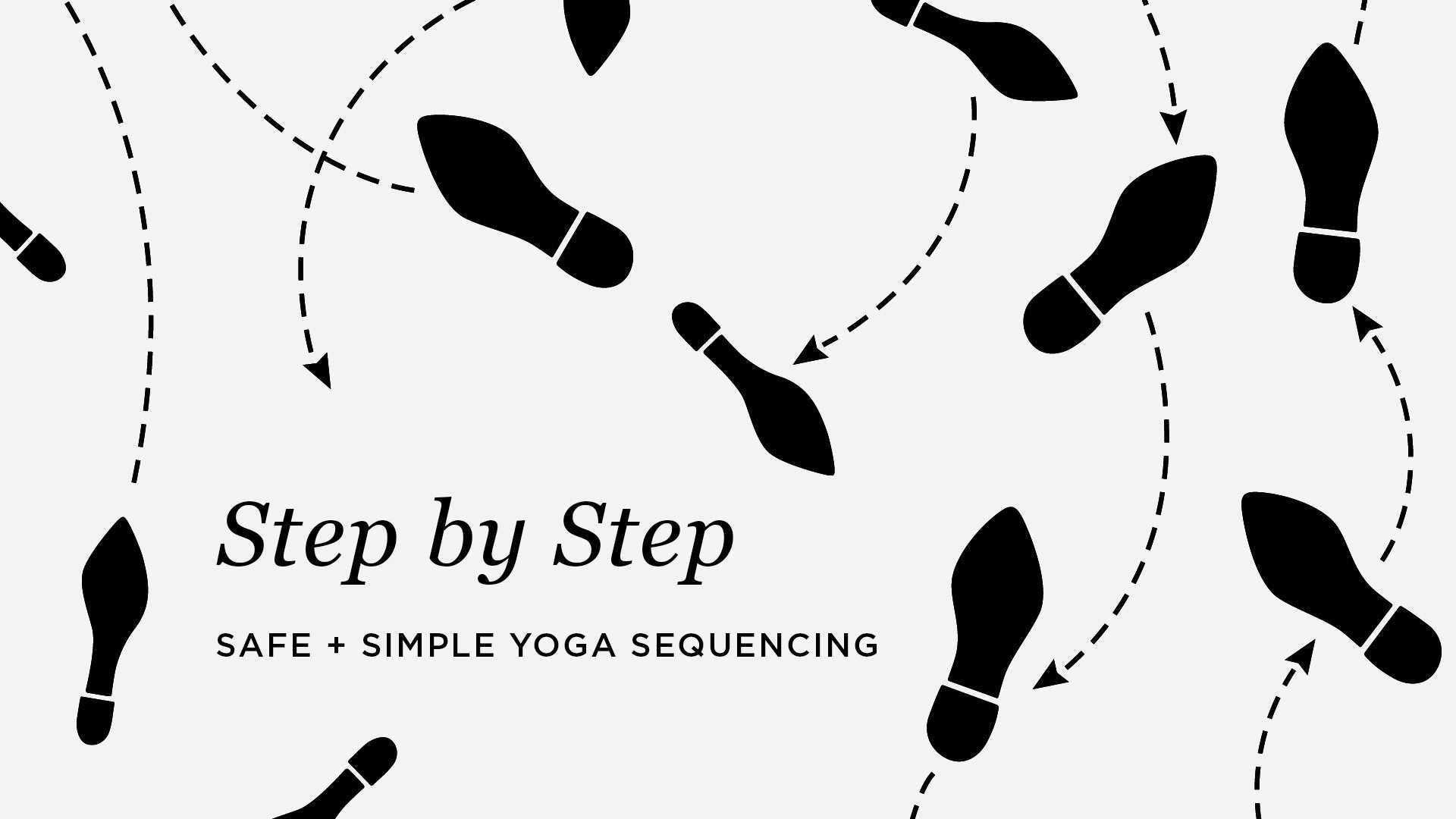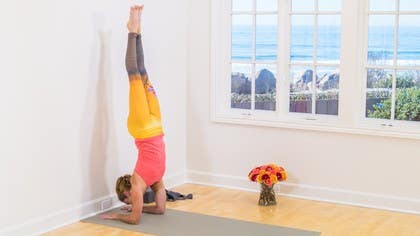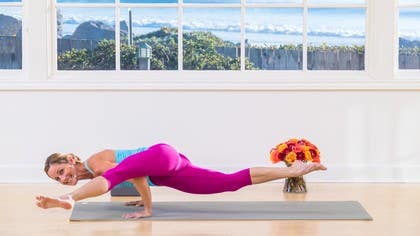Description
About This Video
Transcript
Read Full Transcript
Welcome back. Today we're going to be diving into Pincha Mayurasana. So for this practice you're going to need one block, a strap, and the wall. And so Pincha Mayurasana, Pincha means feather, Mayra, peacock. It's the feather of a peacock pose. So imagine this brilliant iridescent feather, feathers of a peacock. So it's a brilliant pose standing tall, strong. So some of the benefits of this pose is in getting upside down we have to face our fear sometimes, can increase energy. It also is very strengthening and creating stability through the shoulder, shoulder capsules, and also through the back, through the core because we're standing strong and erect and using our energy and our abdomen to draw inward. And also the legs lengthening and strengthening, reaching upward. So some reasons why you might not want to practice this pose today is if you have any injuries of the shoulders, the elbows, the wrists, and actually as well the upper back because it's taking a lot of compression. So you have to be strong enough to be able to stand out of it and not crunch into it. So the energy of this pose is also a Prana Vayu. It's upward lengthening and Apana grounding. So it's this play of opposites, up and down. We're trying to root to rise to get strong and long. So to start we're gonna grab a block to sit on. And if you're comfortable sitting without a block, feel free. And then grab your strap. Just take your seat on down, open up your strap, and just take the tail out to the side and just grab a hold and you're gonna find a space that you can reach up and take a pause. So here we're gonna go back but I want you to slide the heads of your humerus down. So we're creating stability and you can let your hands slide a little wider and just let it go back. Right? Careful if you hyper extend, create a little bend in the elbow. We're just gonna come forward. Just taking a couple times through. Bring your exhale, bring it down. Inhale, take it up. Just take that pause again, setting the shoulder blades down. Reach back. So right here as we start to open up and warm up through the shoulders, notice each time we go back what happens to the chest. So as we come up, the chest one step pop forward. See if you can just find the rib cage to neutral. Slide the shoulders blades back towards each other. Right? So your rhomboids draw them back. Inhale, lifting up. So we're keeping most of the focus right in the shoulders. One more. Come on up. So this time we're gonna move through the same thing but do a pause in the middle and really stretch, try to break the strap apart. So I'm gonna turn behind you so you can see the action. Back. Again, same thing. Grab your strap, slide the tail off to the side. On an inhale, slide on up. And then I want you to take the strap as if you're trying to break it, snap it. And as you do so, I want you to wrap. Wrap your arms so you can feel the armpits start to scoop out. So inner upper arms go back, outer arms forward here. So you're scooping and you're trying to break. Put a little bend in the elbows. So you're finding actions, soften the low ribs, then let it go back. You can let the hand slide if you need a little bit more space. Inhale, bring it up. Take the pause at the top. Find the wrap.
Give a break as if you're trying to snap the strap. Good. Slowly lower it down. Maybe slide the hand in an inch or two. Inhale, come on up. Try to break the strap, snap it, scoop out the armpits, find that rotation in the shoulders. Good. Exhale, take it back. Inhale, bring it up. Wrap the shoulders, snap the strap. Feel that little shaking of the limbs. Angajamayatva. Exhale, lowering down. Alright, maybe one more time, sliding in just a bit. Inhale, snap the strap, wrap the shoulders. Exhale, let it go back. Inhale, lifting up. Snap the strap, wrap the shoulders. Good. Exhale, lower it down. Great. You can take the strap off to the side and still moving with our shoulders because this can be pretty intense on the shoulders. You're going to take your right arm out, thumb up. Start to take the arm up to frame your ear. Wrap inner upper arm back, outer arm forward, and then bend the elbow as if you're trying to scratch your upper back. So one, you can stay right here taking the left arm and just pause. So we're creating a bit more of an opening and we're also playing with this rotation. You can scoop out the armpit a bit, creating a little pocket. Second option, you can take your left arm out to the side, turn the thumb down, reach behind you like you're trying to get a scratch on the upper back, fingertips can touch, and you can also use a strap here. And so keeping a little bit of a space between your right ear and right arm. Just pause. So Gomukhasana arms. Alright, so this translates into so many postures.
A few more. I know as the tendencies we want to start to jet our ribs out, see if you can bring the rib cage back to neutral. Nice, and then softly release. Second side, thumb up. Start to spin the pinky up from deep in the left shoulder joint, frame your left ear. Alright, and from here, bend the elbow, reach back as if you're trying to scratch on your upper back. So from here, hang out here or take the right hand down, thumb down, slide it behind. So some of you like myself might have a tighter side. I like to take my hand behind, give a little help, not too much, just a little bit, and then reach back. If not, use a strap, tau, tie, whatever you have available. The right shoulder rolls back lightly, a little space between the left ear and left bicep. Good, and then wrap the left bicep back. Outer arm comes forward, so still finding that external rotation. Two more breaths. See if you can soften a little bit through the right shoulder. Good, exhale, release. Come on down onto your back, you're gonna bring the block right behind your shoulder blades, as if for the lady is right where your bra strap is, and then you're gonna grab your strap and before you go anywhere, check that your strap is shoulder distance apart, you know, so you can press it and it won't go wider than your shoulders. So this one can feel pretty yummy. Come on to your back, setting up, strap comes just above the elbows, so lowering down can be a little awkward. Find that just set up right, just behind the shoulder blades, good, and then again checking that the buckle is not on the skin. Take the tail out to the side and you're gonna take your arms up overhead, right, for some you might be able to take the strap behind and let the head just rest and melt. So there's still this action of rotation through the arms. So now I'm starting to take my pinkies in, thumbs out from deep in the shoulder joint again, so find that rotation. This is a variation of Urdhva Hastasana on our back, except we get this beautiful, lovely, heart-melty position. If this is too much on the shoulders, come on and sit up, take the strap out, put a block under your head, and just let your arms fall out to the side. Taking two more breaths here, and then slowly coming out, lift on up, easy, slowly. Just slowly take the strap and block out to the side and come on to your forearms and knees. So bring your forearms into a number 11. So this is the forearm-wrist-hand position of Pinchamaya Hastasana. So we're gonna check, wrist creases parallel, and when you set up, check that you're equal distance from the sides of the mat, right, it's just starting to be disciplined with the the integrity of the pose, just so we don't get lazy. Middle fingers forward, and so there's an Hasta Bandha. There's a bit of pressing down, rooting, but Hasta Bandha we're drawing up with energy as well. Forearms press, shoulders are gonna be right over the elbows. So the hard thing about this pose is keeping the pointer finger, thumb, and inner wrist down, because what I see a lot is this lift up of the base of the pointer finger, base the thumb, and the inner wrist to keep that down. It's much easier when we come into these prep poses to interlace and press the outer wrist down, because your two forearm bones lay much more even this way. As soon as we press the palms down, they cross, and it makes it harder to keep it down. So I've learned in this pose that the brain of the pose is right here, keeping this area glued down, right, other important pieces to the pose, but the brain right there. So start here, and then take your feet back, coming into a bit of a plank pose, and I think I've heard this one called Dauphin Plank. I always get groans when we start to go into this one into class. So here you can start to line up shoulders over elbows, and then check in wrists in line with elbows, middle fingers forward. So you start to turn on the core, right, so we're drawing inward towards the midline, pressing out through the heels, and when we get upside down you have the choice to go through the balls of the feet or through the heels, right, different variations, all kind of fun. So just pausing here, building a little bit of heat, right, for folks that in my class that say, oh I want to work towards that pose, this is where we start and this is where we stay for a long time, right, so it's building shoulder strength, shoulder stability, and then working through the core. Take a moment to come on down to the knees and pause. So in this pose, when we come into this number 11, what we tend to see happen is the hands slide in, the elbows slide out, so then we start to lose this alignment and the integrity in the pose, and the more we can keep this integrity, it makes it easier because we're stacking things instead of having our foundation be all catty wampus, so it's solid firm. Come on back, press down, create that number 11 again, curl the toes under, creating a plank pose, and then I want you to give a little press towards your upper back, right, so not so much rounding through the whole back, but a press up through the upper back, and you'll feel your sides run right under your armpits on the side of your ribs, kind of fire up, that's your serratus, so that starts to strengthen and broaden through the upper back, and then let the heart come forward a little bit, so as you do so the shoulder blades start to squeeze in, those are your rhomboids, so feel that kind of play between the two, right, so in this pose we're gonna find both a broadening through the back and also the heart coming forward a bit, so the shoulder blades start to slide in, great, come on down to the knees, we're gonna move into standing, coming into Tadasana, so start with your big toes to touch, heels gapped, and usually when I teach Tadasana Mountain Pose, offer the standing hip distance apart, softening a little bit, but since we're going upside down, I like to bring the feet in towards each other, just to create that action, that seaming up of drawing the energy in all the way to the midline, and the legs can be active, not over the top, straight or knee cap slightly lifted, right, so finding this play between action and not over the top intensity, okay, so inner ankles lift a bit, outer ankles draw in, see me again into the midline, we start to take the inner thighs towards each other, and there's a little rotation back, right, that broadens out the sacrum, and trying not to overdo it, we want an equal press of the outer thighs back, because sometimes what happens is we start to really work that inner rotation and then the outer thighs come forward, it's pretty awkward, so finding an equal balance, finding the hips lifting just likely to create space, not tucking or splaying out the tailbone, so we're finding neutral, so for some of us it takes a little bit of time to find neutral, belly lengthens, spine lengthens, so we're creating space, we're getting big, back broadens, and to do this you start to lift the chest, so your pectoralis muscles lift up a bit, and then your upper pecs actually relax, so it's lower pecs lift, upper pecs relax, find a rotation that we just went through in the upper arms, inner upper arms forward, outer arms back, back side of the shoulder draws the shoulders back, and you can feel the shoulder blades start to span out a little bit, working back into that serratus muscle, and you can feel a slight draw in the rhomboids of the shoulders, right, so all this is gonna play out when we're upside down, good, so we're gonna come on back down, you're gonna need a block and a strap, so setting up your strap that it's shoulder distance apart, okay, so just give a little check, give a press out, because when we set this up we're actually pressing against the strap, and it's gonna give us this rebounding, a lighter lift and easier to get up, and it actually stops us as well from this, right, that action that tends to happen in this pose, so it keeps it there, it doesn't allow our elbows to drift out and won't allow the hands to drift in, so check that that's equidistant, taking the block, for the first hand position we're gonna do more of a karate chop, so initially when I set up in this practice, when we were practicing the arm position, I talked about the bones and how much easier it is to do the pose with the thumbs up, right, it starts to get hard when the bones cross, keeping the brain of the pose on the floor, so we're gonna go with the karate chop, fingers are gonna press towards each other and then in, and then we're gonna keep the outer edge of the forearm down pressing, so bring that on to the wall, get your strap on, and as you set it up imagine that you're trying to snap the strap, you're trying to break it, so you're creating some space, get the tail on out of the way, set your hands up in that karate chop, and then curl the toes under, right, with the curls, toes curled under, this is just like downward facing dog from the shoulders back, so depending on your hamstring flexibility will depend on how far you can walk in, right, so you always have the option to stay right here, this can be plenty and this can be where you're working, right, if this even feels like too much, walk the legs back out, come down onto your knees and you can work right here, if you want to turn it up, right here, or walk the feet in, for some you can start to inhale, take the right leg up, and then come on to the ball of the left foot, so you feel the weight into your forearms, and then lift the shoulders up, shoulder blades are lifting up towards the heel a bit, and then you could take your gaze slightly down, right, further into the pose, you can start to take it forward, but for now just keep it right here, good, exhale bring the right foot down, inhale take the left foot up, and then come on to the ball of the right foot, and just taking a few breaths here, feeling the rooting, the rising, the wrapping of the serratus, the drawing of the shoulder blades towards each other, good, exhale, come on down into child's pose, right, so take the strap out, bring the forehead down, and just let yourself relax, let the shoulders go, if you can take the arms back behind, so you can completely let them go, moving into the second one, bring your strap back in this time, you can stay with all of those that were offered, or we're gonna come on up, so karate chop, press the palms in, curl the toes under, lift on up, if you can take one leg up, and then from here start to either hop, or just drift on up, so notice when I put my feet on the wall, notice the arch in my back, so actually using the wall takes us out of position, so what I want you to do is to lift, if you can, take one foot off the wall, one heel on the wall, and press up, that take two breaths here, and then switch, one and one, let's slowly come on down, unwrap yourself, and then come into child's pose, just to rest the shoulders, good, round two is kind of more fun, it's an option, you can stay right where we were with the karate chop, or we're gonna play with taking the arms, turning the palms up, and then keeping them here while we go upside down, notice if you flip your palms up, almost like just reversing your hand position here, and then take your arms away, right, so the elbows want to come in, here that's pretty hard to do, so here it's just keeping all of this solid and getting a good stretch on the wrists, right, so it's either staying with the karate chop, or we're gonna flip our palms upside down, bring the strap back on, take the tail out to the side, so lining up the bottoms of your hands with the bottom of the block, and so the hard thing is to start to seal down the thumb, you'll see I'll have a little bit of space, but I'm trying to work it down, good, come on to the balls of your feet, and just take a moment a breath or two here, happy to stay right here, or for some, see here, for some start to walk it in, so as you arrive, press through the forearms, lift through the chest a bit, and you can work heels up the wall, you can work balls of the feet up, you can play with the balance, slowly coming down, taking a pause in child's pose, and then coming on up now, coming into our regular hand position, right, so we're trying to move towards ball of the pointer finger to the base of the block, thumb to the bottom, but notice there's a little space between the block and the bottom of my thumb, if we press it against there, it creates a little hyperextension, so we want to create that space, and keep it there, pressing base the thumb, base the pointer finger, interest into the floor, and using the block to stop us from drifting in, using the strap, from stopping us drifting out, so all this focus on the shoulder girdle, let's see if we can then bring awareness to our whole body, starting to draw in and then up, so bringing back the strap on, take the tail out to the side, come on down to your knees, line up, ball of the pointer finger, curl the toes under, coming into Pinchamayasana prep, curling the toes under, feel free to stay right here, and then if you'd like, slowly come on up, so wherever you are, feel free to take the feet up the wall, heels up the wall, find a press through the palms, press through the forearms, good, and then feel the serratus wrap, feel the legs lift up long, nice, and then slowly come down, lovely, coming into one more Pinchamayasana, choice of using the block or not, so if you're going to stick with the block, it's to keep the hands in place, sticking with the strap is to keep the shoulders and elbows in a line, maybe trying it in the Pinchamayasana prep pose to see if they can maintain placement, so come on down into the number 11 with the arms, lining up middle fingers forward, seal down, base the pointer finger, base the thumb in a wrist, forearms root, shoulders over elbows, and then come into Pinchamayasana prep, notice here if there's any drifting of the hands or elbows, then come back to a block and strap, if not, come on up, so we're going to inch our feet forward, taking one leg up, it might be a hop, might be a reach, right, when you arrive there's a press to reach and lengthen, so shoulder blades come a little bit towards each other to bring the heart a little forward, and then lift up and out, seeming down the midline lengthen through the low back, taking energy out through the feet, and then slowly come down, come on into Child's Pose, take the arms behind, just let it go, take a moment of feeling from getting upside down, how that increases your energy, and then slowly coming on up to a comfortable seat, right, so lots of places to focus on in this pose, from the wrists, to the forearms, to the shoulders, chest, back, long line of energy, so right from the chest down we can focus on Tadasana as a blueprint, right, and from up we can keep playing with this Daphan plank to build strength, to be able to stack elbows over shoulders, okay, so I hope you enjoyed today, thank you for practicing with me, and namaste.
Step By Step
Comments
You need to be a subscriber to post a comment.
Please Log In or Create an Account to start your free trial.









